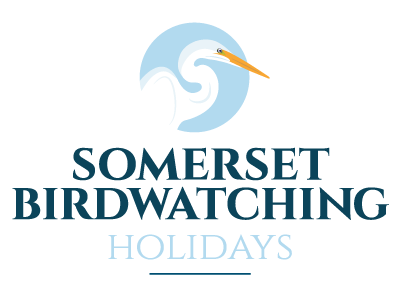Starling Murmurations are back
Friday 22nd November
We left Walls Farm early afternoon, to meet Stephen at RSPB Ham Wall. An eventful journey, with large flocks of Fieldfares and redwings along the hedgerows and about 20 Cattle Egrets (our newest exotic!) near Mudgeley. At a damp (and fairly empty) Ham Wall there was a female Sparrowhawk over the car park, Great Spotted Woodpecker, Goldcrest, and an astonishing 86+ Cattle Egrets flying back and forth in the distance south of the railway bridge. Just before the first viewing platform, we caught sight of a flock of about 80 Black-tailed Godwits (all in non-breeding plumage) flying around, plus several Marsh Harriers, and a Great White Egret fishing along the bank of the drain, just as the rain began to ease off.
From next to the platform (which was being rebuilt) there were the usual ducks and Coots (including Wigeon) and quite a few Lapwings, as well as the godwits on the deck, a Buzzard drying its wings at the back of the lake, a Little Grebe, and we also heard Cetti’s Warbler and Water Rails. The Great White Egret then perched on a wooden structure “like Olga Korbut” as Graeme explained (he has a long memory!) We walked along to the second viewing platform (also being rebuilt), where there were several more Marsh Harriers, a dozen Snipe overhead, and Canada and Greylag Geese. Then it was back for the start of the Starling roost. The first arrived at 15.39, by which time it had stopped raining. Over the next half hour more and more Starlings came in and began their ‘murmurations’ – performing very well over Walton's and Loxton's Marshes, providing us with a splendid spectacle. By 16.20 all the birds were down; and had started calling loudly to one another; a Kingfisher also flew briefly overhead. By now it had turned into quite a pleasant evening, and we headed back to Walls Farm for our first splendid dinner from Kay!
Saturday 23rd November
Saturday also dawned rather damp, though once we arrived at WWT Steart Marshes the skies began to clear. Graeme spotted a Stoat running across the entrance to the car park, while a very obliging female Kestrel alternately perched on a huge pylon or hovered in front of us; there were also flocks of Goldfinches coming to the feeders and several Pheasants in the field near the hides.
From the Quantock Hide we could see large numbers of birds: mostly a large flock of several thousand Lapwings, plus good numbers of Golden Plovers, Shelducks, Teal and a few Dunlin feeding in front of the (mostly) sleeping birds, plus several Little Egrets – our third and last egret species for the trip. We then moved into the front-facing hide, where we picked out a Kingfisher that sat briefly on a gate in the middle of the marsh, and more waders, including Redshank and – a surprise and our first record for a SBH trip – a splendid non-breeding plumage Spotted Redshank which obligingly flew closer and fed in deep water, showing off its long bill and legs, pearl-grey plumage and white face flashes. A couple of Avocets also flew in.
Spotted Redshank
From here we drove through Bridgwater to the southern part of the levels near Stathe, where we embarked on our usual wild goose (or should that be wild crane) chase. These huge birds are surprisingly tricky to find, but while we were scanning, we had great views of a Barn Owl, hunting in the gaps between the drizzle. We then heard the distant calls of Cranes, and eventually caught sight of a few very distant birds, one of which flew. Frustrating but ‘tickable’ views – just! We also saw two Great White Egrets, several Little Egrets (all feeding along the very high river or in nearby fields); and a pair of Stonechats (the male of which showed well).
A three Barn Owl day is always a good day…
After our usual excellent lunch break at King Alfred Inn at Burrowbridge, we headed back to Ham Wall; for a second go at the Starlings roost. They did not disappoint: while we also had time to watch a pair of Marsh Harriers, the usual Lapwings, snipe and ducks from the viewing platform, and the flock of Black-tailed Godwits. The Starlings started to come in from about 15.40 and were still coming in at 16.20, well after sunset. On the way out two Great White Egrets flew over the car park; while on our way back across Tealham Moor an obliging Barn Owl appeared, followed by brief views of a second – our third of the day! Then back to Walls Farm for another splendid supper.
Sunday 24th November
We headed up to King’s Wood, Cheddar, on a much milder day. A pair of feisty male Robins were squaring up to one another by the car park, arching their backs and tails. We also heard and saw several Nuthatches and a pair of Coal Tits, before heading up to Cheddar Reservoir.
From the Cheddar Tower, conditions were a little murky but otherwise very good (no wind!); we could see lots of gulls of four species (Herring, Lesser Black-backed, Common and Black-headed), and the Black-headed Gulls were perching and preening on the nearby rail around the tower. Also, about 1500 Coots in the distance, lots of Great Crested Grebes, Cormorants, and various ducks including about 50 Pochards and 4 Red-crested Pochards, including a very pale (leucistic?) female and a splendid male.
In Cheddar pool we had brief views of a Kingfisher flying over our heads, followed by a Grey Wagtail overhead calling – the last bird of a very good trip – before he headed back to Walls Farm, and said our goodbyes.
TOTAL SPECIES: 75 (+ 5 recorded separately on 21st Nov)


